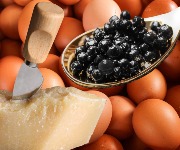How to make ciabatta
Jennifer Ah-Kin explores the surprising history of everyone's favourite Italian bread, and shows us how easy it is to make ciabatta at home
Ciabatta is a bread more famous for its airy holes than its actual taste, and named for its passing resemblance to an Italian slipper. M&S first introduced most Brits to this squat misshapen loaf in 1985, and we've not looked back since. But is there more to the humble ciabatta than its current role as a posh sandwich alternative? And how do you bake your own, giant air holes and all?
A surprisingly modern classic
We like to think of Italy as the country of never-ending food history; that every Italian family harbours a fiercely guarded set of recipes, passed faithfully from nonna to mamma down the ages. It comes as somewhat of a shock, then, to find the modern ciabatta had its birth in the heady days of 1982, as the invention of one Signor Arnaldo Cavallari. Similar breads had existed previously, but it was Cavallari's copyrighted Ciabatta Polesano, and later his Ciabatta Italiana, which propelled the ciabatta to its current status as everyone's favourite Italian bread.
Wet wet wet
So how to achieve the ciabatta's supremely airy crumb? Firstly, the water: 'I used a very soft, wet dough, with a lot of water - very watery,' said Cavallari in an interview with the Guardian. While most bread recipes call for a hydration level of 60-70% (i.e. for every 100g of flour, you add 60-70g of water), ciabatta dough hovers around the 80% mark – leading to a very sticky, near-unmanageable dough.
To tackle this runny dough, many recipes recommend using stand mixer, while some bread books flat out refuse to provide hand kneading instructions. But kneading by hand is indeed possible – you just need patience and the willingness to get stuck right in.
Tip #1: check out this video clip by Amy Scherber of NYC bakery Amy's Bread (skip to 3:15 for the kneading section) for a good method for kneading wet dough.
Tip #2: For handling a wet dough, a plastic bread scraper is your new best friend. Use it to keep the dough in check, scraping it into the centre of the table when it starts to spread too much. If you don't have a bread scraper, you can use a flat spatula instead, or order a scraper online from a bread equipment supplier.
Thinking biga
Another key component of the ciabatta process is the use of a starter or biga (pronounced bee-ga). This mix of flour, water and a pinch of yeast is left to stand overnight, then added to the rest of the ingredients the next morning. The biga lends gluten strength to the dough, helping the creation of those olive-oil catching holes as well as imparting greater flavour to the finished bake.
If you'd like to make ciabatta, here's my easy-to-follow recipe.
What to serve with your freshly baked ciabatta? Why not try:
Stella McCartney's Winter minestrone
Most Recent
Comments
Be the first to comment
Do you want to comment on this article? You need to be signed in for this feature








